Section #1 - America’s years as a British Colony end with The Revolutionary War
Chapter 1: The Earliest Settlers Appear
TIME: 1600 – 1860
From the mountains, to the prairies, to the oceans white with foam…the land awaited its first settlers
The North American Continent
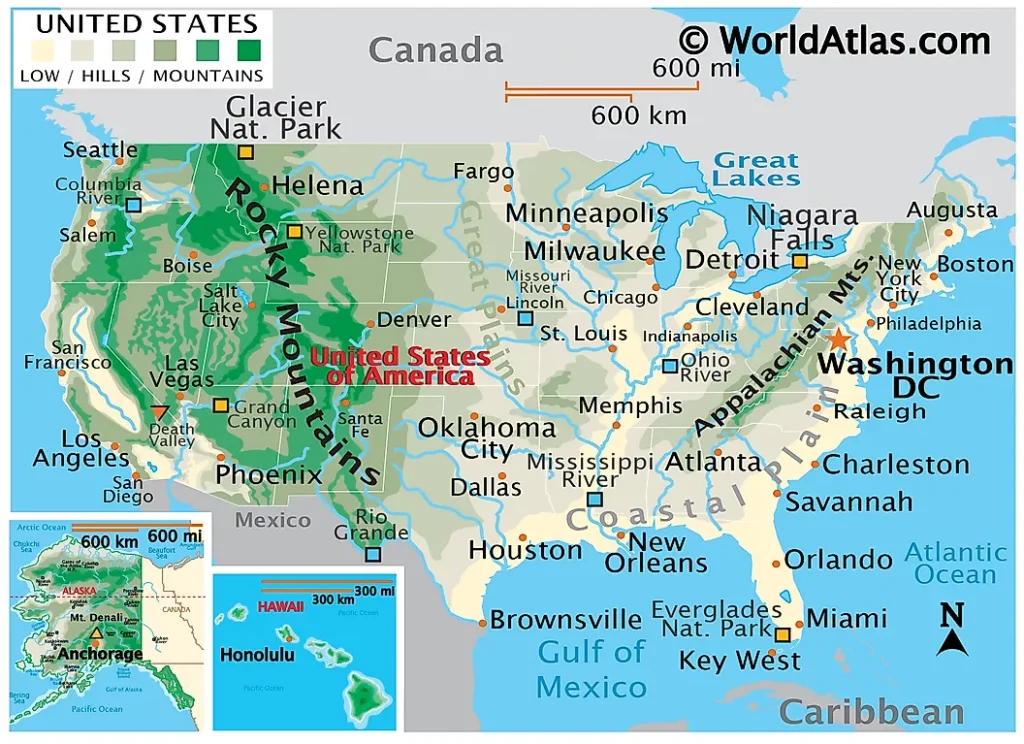
Time: 16,000BC to 1500AD
Native American Tribes Arrive
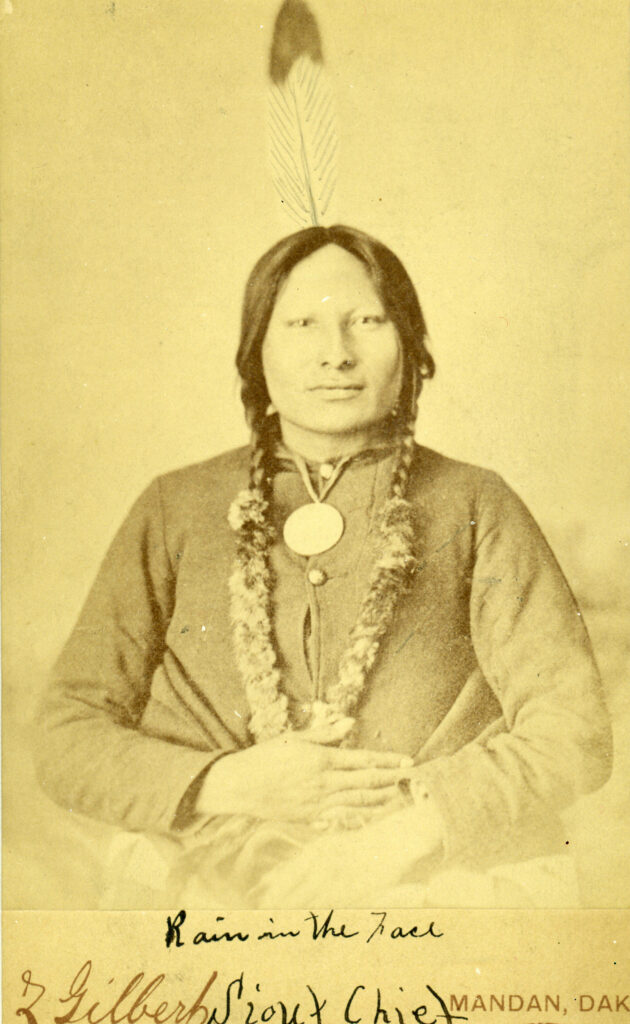
Starting around 16,000 BC, or earlier, America’s first settlers wend their way across a 1000 mile “land bridge,” formed by a sea level drop in the Bering Straits, which once linked the eastern edges of Siberia to western-most Alaska. Their facial features signal an Asian heritage, and they are typically dark complexioned. They operate in tribes and become adept at both hunting and gathering. They are the first farmers of the land, sustained by a wide range of indigenous crops, including corn, potatoes, peanuts, chocolate, cotton and tobacco.
Thus the New World is Born.
Over time the settlers fan out across the northern continent, east to the Atlantic coast and south through Mexico to the southern hemisphere. Along the way they build enduring civilizations. The Tlingit people of the Pacific Northwest master the arts of fishingand record their history on totem poles. The Hohokam tribes of Arizona introduce
The Hopewell nation flourishes in the Midwest from Missouri to Wisconsin and east through Illinois and Indiana, their past evident in huge burial mounds throughout the region. The Algonquians extend across Canada from the Rockies to New England, chasing seasonal food supplies with their portable wigwams. They eventually collide with the Iroquoians, who flourish in New York and the upper Atlantic states. Meanwhile the Southeast is home to what will later become known as the “five civilized tribes” – the Cherokee, Choctaws, Creeks, Chickasaw and Seminoles. By 1500 AD Native American civilizations, speaking upwards of 250 unique languages, dot the landscape from coast to coast.
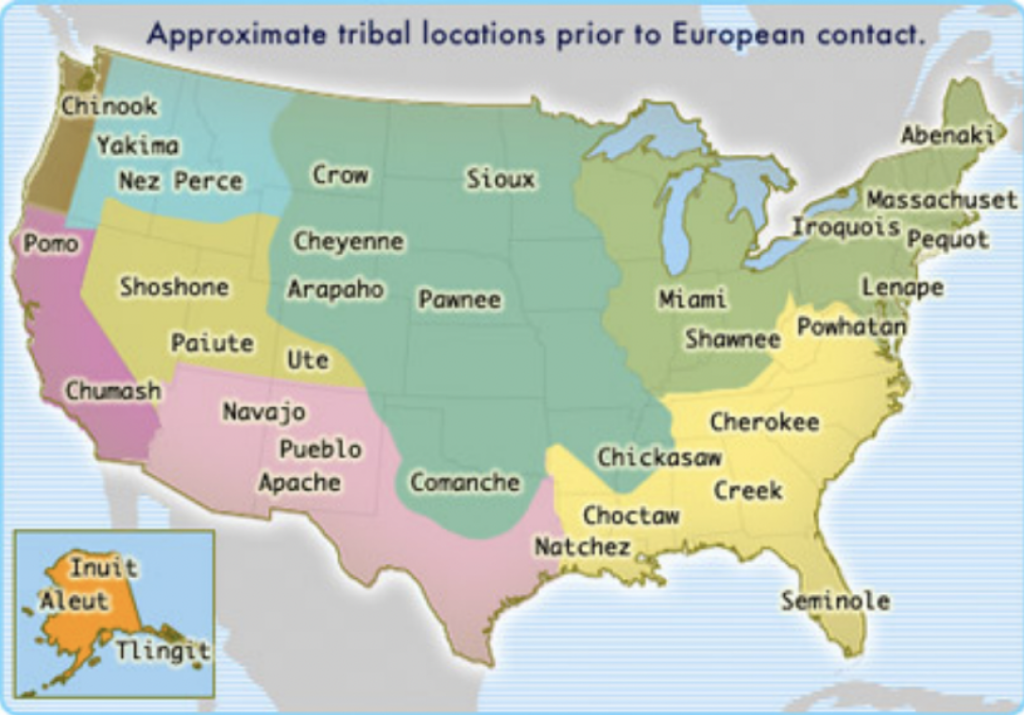
There are no reliable population statistics for this timeframe, but estimates tend to range upwards of 10 million people – at the time European explorers intrude on their homeland.
Time: 1492
Columbus Reaches The New World
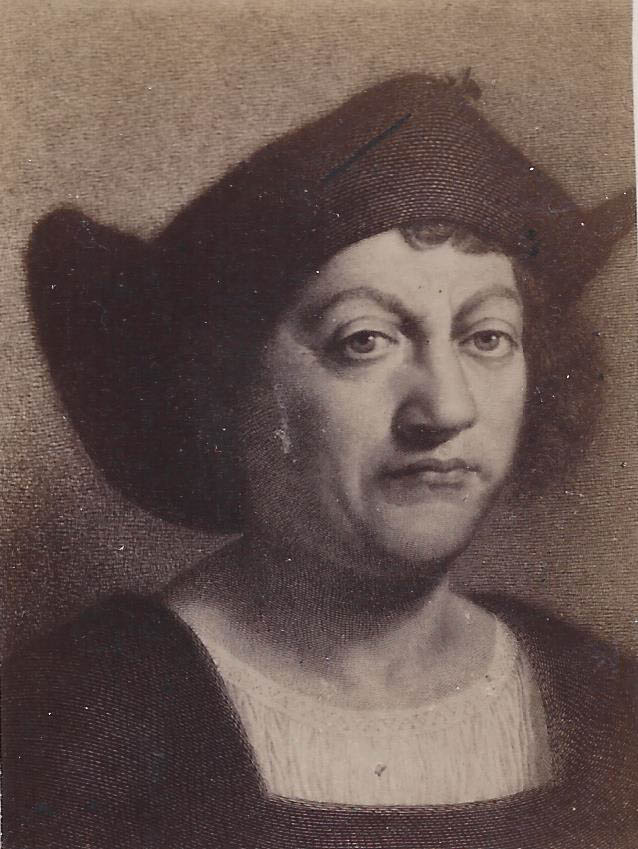
The European intrusion into the New World begins by accident. Since Roman times, Europe is attracted to the spices of Asia – cinnamon, cardamom, ginger, pepper, turmeric, not to mention opium. But the overland trade routes to the East are precarious. Instead, perhaps by sailing west, a shorter and more commercially favorable route could be found.
This is what Christopher Columbus has in mind on October 12, 1492, when he begins his voyage with three ships, in service to the Spanish crown. After 70 days at sea, he encounters land, most likely the tiny island of San Salvador. From there he spends the
next three months navigating his way south to Cuba, then east to Hispaniola (later Haiti and the Dominican Republic). Along the way, he encounters natives with gold earrings, whom he describes as docile in nature, lacking in weaponry, and easily capable of being conquered, converted to Christianity and placed into servitude.
Still believing he has found his way to India, Columbus refers to the islands as the East Indies, and the natives as “Indios” or Indians. He kidnaps many along the way, and some 7-8 who survive the journey home are put on display as proof of his success. On March 4, 1493 Columbus is back in Portugal. Despite losing his lead ship, Santa Maria, and failing to locate any spice treasures, his encounter with the Caribbean islands sets off an exploration frenzy that lasts over the next two centuries.
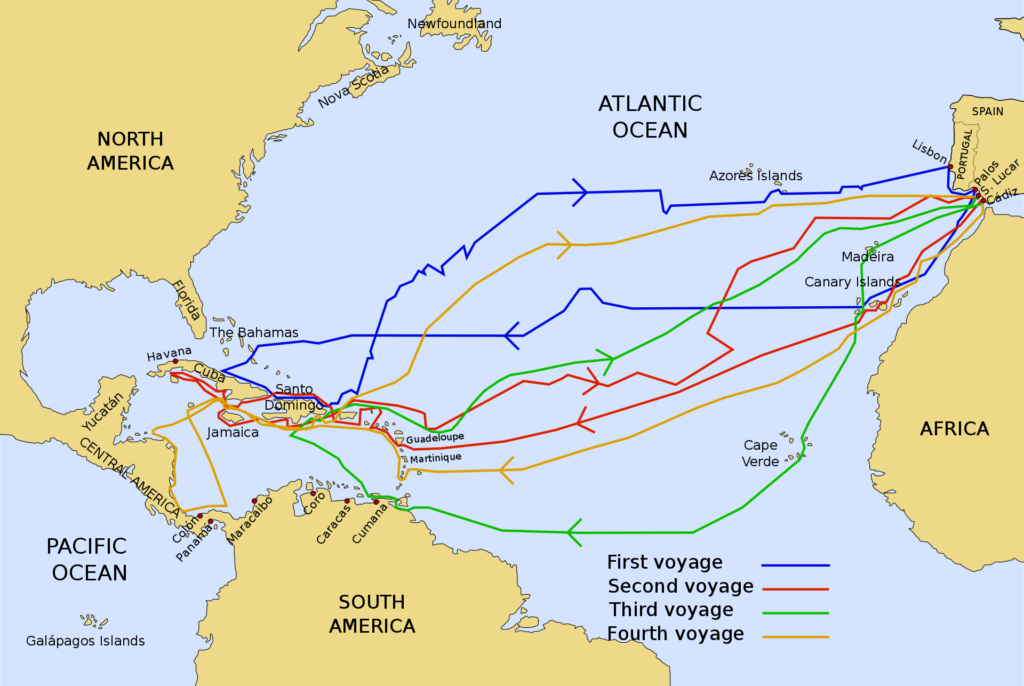
Within a decade of the 1492 voyage, Europe recognizes that Columbus has reached a whole New World, rather than Asia. The Italian explorer, Amerigo Vespucci, argues this fact after his 1502 voyage, and in 1507 a German mapmaker, Martin Waldseemueller, officially christens the continent “America” in his honor.
Time: 1492-1602
Spain Leads The European Invasion Of The Americas
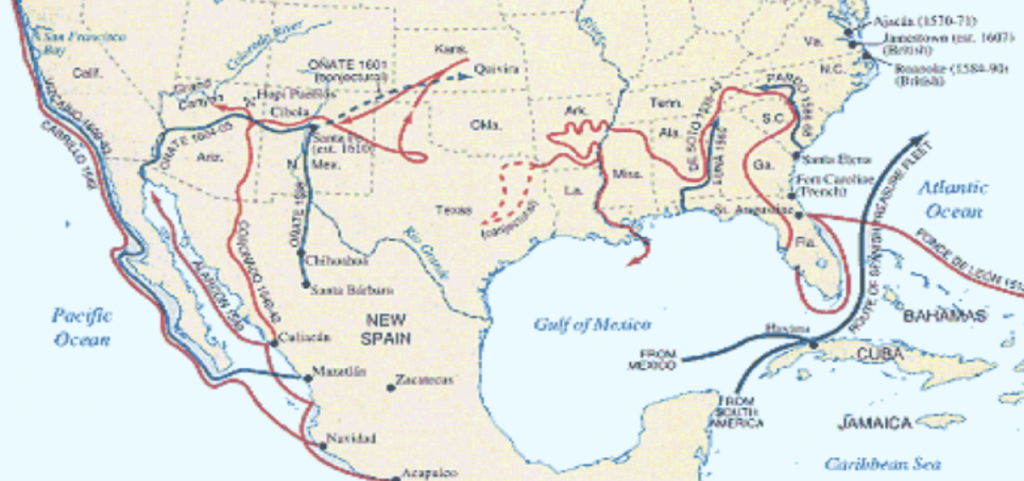
In turn America becomes a sought-after chip in the game played by the monarchs of Spain, France and England for control over Europe and for global hegemony.
Spain takes the lead as the dominant power in Europe after the 1469 marriage of two Catholic monarchs, Isabelle of Castille and Ferdinand of Aragon, unify the nation, and dynastic matches of their children extend their power into Portugal and the Hapsburg dynasty.
It is their grandson, Charles I, who reigns supreme from 1516 to 1558 over much of Europe, including Spain, Italy and the sprawling remnants of the Holy Roman Empire, from the Netherlands in the north to Austria-Hungary in the south.
King Charles is a Catholic monarch, who battles against the Protestant Reformation, sparked by Martin Luther in 1517, and against France in various European wars. He is also remembered for sending his conquistadors across the Atlantic after gold and territory in the Americas.
Two remarkable civilizations fall to his swords and cannon in short order, as Hernan Cortez conquers Montezuma and the Aztec empire by 1521 and Francisco Pizarro ends the Incas rule over Peru in 1541.
Hernando De Soto rampages through Central America and the Caribbean, then north to Florida and west to Louisiana. Alvar Cabeza and Francisco Coronado extend De Soto’s tracks in America, driving through Texas to Arizona and up through Oklahoma to Kansas. Some fifty years later, in 1596, Sebastien Vizcaino explores the west coast, from San Diego to Oregon.
So Spain is first to assert its “rights” throughout the New World.
By 1600, it controls much of the Caribbean Islands, Peru, Central America, Mexico, and over half of the North American continent from Florida across the deep South to San Diego, then north to Oregon.
The European Exploration Of America: Early Spanish Expeditions
| Years | Explorer | From | Land Covered |
| 1492-1504 | Columbus Christopher | Spain | San Salvador, Cuba, Haiti, Trinidad, Jamaica, Venezuela, Mexico, Honduras, Panama |
| 1493-1521 | De Leon, Ponce | Spain | Santo Domingo (DR), Puerto Rico, Florida |
| 1497 – 1498 | Cabot, John | England | Newfoundland |
| 1497 – 1538 | Da Gama, Vasco | Portugal | Opens trade route with India (“the Indies”) |
| 1499-1502 | Vespucci, Amerigo | Italy | S. America, recognizes that new world is not Asia |
| 1519-1521 | Cortez, Hernan | Spain | Mexico, conquers Montezuma and Aztecs |
| 1524-1542 | Da Soto, Hernando | Spain | Nicaragua, Peru, Cuba, Florida, Louisiana |
| 1524-1528 | Verrazzano, Giovani | Italy | Cape Fear, NC, New York, Maine, Newfoundland |
| 1528-1537 | Cabeza, Alvar | Spain | Cuba, Florida, Louisiana, Texas, Mexico City |
| 1532-1541 | Pizzaro, Francisco | Spain | Conquers Incas in Peru, into Panama |
| 1534-1541 | Cartier, Jacques | France | 1000 miles up St. Lawrence seaway |
| 1540-1542 | Coronado, Francisco | Spain | Arizona, NM, Texas, Oklahoma, Kansas |
| 1577-1580 | Drake, Sir Francis | England | 2nd after Magellan around the world, California |
| 1584-1587 | Raleigh, Sir Walter | England | Roanoke colony (NC) in 1584-87, Florida |
| 1596-1602 | Vizcaino, Sebastian S |
But Spain comes to the New World more as plunderers than as settlers. In North America, their main attempts at establishing deep roots occur in the Floridas, notably at St. Augustine in 1565, in Santa Fe around 1598 and Texas in San Antonio by 1717.
The failure of Spain to populate and formally colonize in North America will come back to haunt them when their land claims are later threatened by France and the United States.
| Year | Location |
| 1585 | St. Augustine, Fla |
| 1696 | Pensacola, Fla |
| 1718 | San Antonio |
| 1772 | St. Luis Obispo, Ca |
| 1780 | Yuma, Az |
| 1786 | Santa Barbara, Ca |
| 1828 | San Francisco Solano, Ca |
Time: 1497-1611
Britain Begins To Colonize America
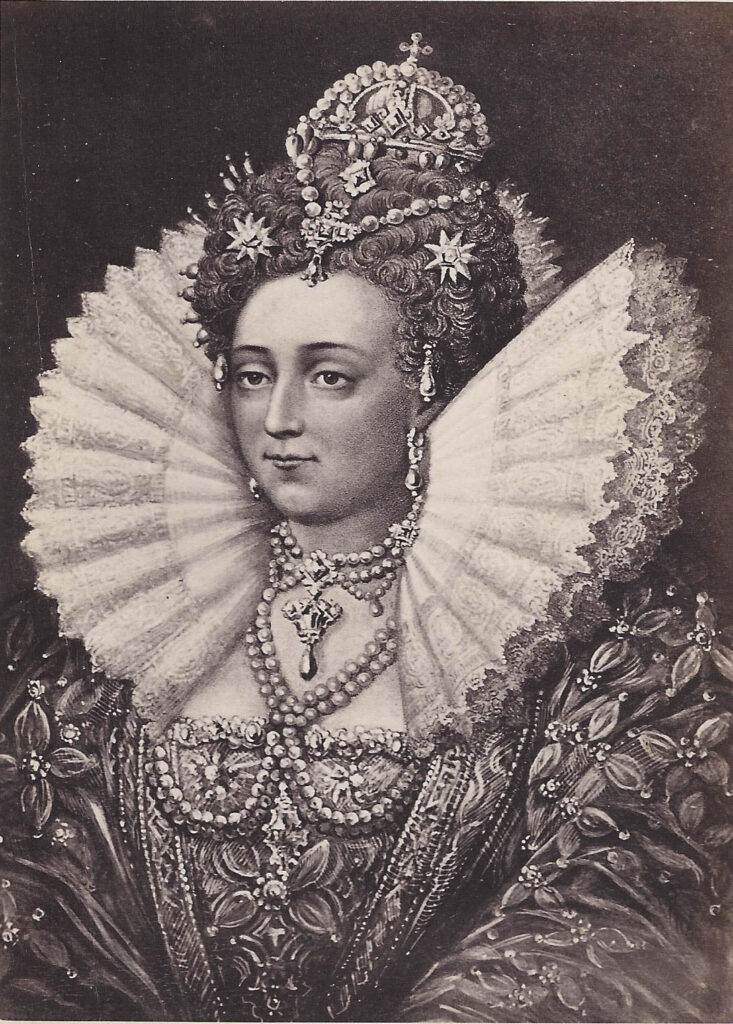
Aside from John Cabot’s 1497 voyage to Newfoundland, the English show little early interest in the New World.
This changes, however, during the reigns of Queen Elizabeth, from 1533 to 1603, and King James I from 1603 to 1625.
Once they turn their attention toward America, England’s strategy differs sharply from the Spanish. Instead of in and out probes for gold and silver, the English set their sights on establishing permanent colonies on the continent, to work the land and carry on profitable trade over time.
The development of Britain’s Royal Navy during Elizabeth’s reign assures Britain’s control over the sea lanes required for safe import and export of goods.
British merchants and the crown begin to formulate a “business arrangement” that will create incentives to build permanent colonies across the ocean. The solution is the “joint stock corporation,” a model that will become a permanent feature of the future economic landscape in America.
“Corporations” begin as a legal agreement between the monarch and a set of private investors (“stock owners”) based on a mutually agreeable “exchange.” In this case, the crown grants ownership of sizable chunks of land in America to investors in return for sponsoring settlements that create and sustain trade.
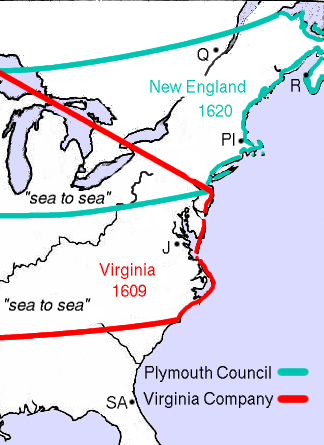
The principal corporation during Elizabeth’s reign, The London Company, is granted Atlantic coast territory extending from the 34th (Cape Fear, North Carolina) to the 41st parallel (Long Island Sound). This results in England’s first American settlement, the Roanoke Colony, set up by Sir Walter Raleigh in 1584 on lands he calls Virginia, in honor of the Virgin Queen. But when long delayed supply ships from England revisit the colony in 1590, all signs of the 110 settlers have vanished without a trace.
The “Lost Colony of Roanoke” halts English colonization until King James I grants two pivotal and somewhat overlapping charters in 1606:
Joint Stock Corporations Chartered By James I In 1606
| Company Name | Grant Longitude | Primary Development Areas |
| Virginia Company of London | 34th to 41th parallel | Virginia, North Carolina |
| Virginia Company of Plymouth | 38th to 45th parallel | New England |
On May 13, 1607, 105 men led by Captain John Smith land at Jamestown, Virginia, with their London Company charter ordering them to accomplish three things:
- Find Precious Metals
- Establish a Protestant presence on the continent; and
- Expand English Naval Power
But like Roanoke, Jamestown is almost another failure. There is no gold to be found, malaria strikes, and in June, 1610 the 38 survivors re-board their ship to head home. Destiny shifts, however, when sailing out on James River, they encounter a second wave of London Company settlers and return, 1700 strong, to search again for a path to prosperity. After experimenting with a series of possible exports, from timber to iron to sassafras, the colonists finally settle on tobacco, which becomes an overnight sensation in Britain, and triggers the formation of other southern colonies: Carolina in 1629 and Maryland in 1632.
On August 13, 1607, the Plymouth Company lands a contingent of 120 souls, under the command of George Popham and Raleigh Gilbert, on the southwest coast of Maine, near the mouth of the Kennebec River. While they are able to construct Fort St. George, hard living conditions and a falling out between the leaders causes the colony to close after its first year.
A second Plymouth Company venture proves more successful. On December 21, 1620, Captain William Bradford, a Puritan separatist fleeing the Church of England, navigates the aging ship Mayflower and its 102 “pilgrim” passengers into a harbor at Plymouth, Massachusetts. His first impressions are anything but uplifting:
It is a hideous and desolate wilderness, full of wild beasts and wild men
Surviving the winter, they establish a toe-hold in America, and are joined in 1628, by settlers associated with another corporation — The Massachusetts Bay Company.
The British then consolidate control over the entire Atlantic coast in 1664 by forcing the Dutch to surrender their claim to the New Netherlands territory, in and around the island of Manhattan. This claim originates with Henry Hudson’s 1609 voyage on behalf of the Dutch East Indies Company. By 1626 its Director-General, Peter Minuit, has “purchased” the island from the Delaware tribe and constructed Ft. Amsterdam to defend the harbor.
But the Dutch defenses are no match for the four British frigates that appear on August 27, 1664, and demand surrender. By 1665 New Netherlands has officially become a New York colony, and the Manhattan settlement of New Amsterdam is re-christened New York City. A final treaty to this effect is signed in 1674, after conclusion of the 3rd Anglo-Dutch War.
Early Exploration Of America: English Expeditions
| Years | Explorer | From | Land Covered |
| 1497-98 | Cabot, John | England | Newfoundland |
| 1577-80 | Drake, Sir Francis | England | 2nd after Magellan around the world, California |
| 1578-83 | Gilbert, Sir Humphrey | England | Newfoundland and Nova Scotia |
| 1584-87 | Raleigh, Sir Walter | England | Roanoke colony (NC) in 1584-87, Florida |
| 1596-1602 | Vizcaino, Sebastian | Spain | Pacific coast, San Diego to Oregon |
| 1603-09 | Champlain, Samuel | France | Settles Quebec |
| 1606-14 | Smith, John | England | Jamestown in 1607, Richmond, Baltimore |
| 1607-08 | Popham, George | England | Maine |
| 1609-11 | Hudson, Henry | England | New York (for Dutch East Indies Co.), Hudson R |
Time: 1664-1732
A Total Of Thirteen British Colonies Are Established
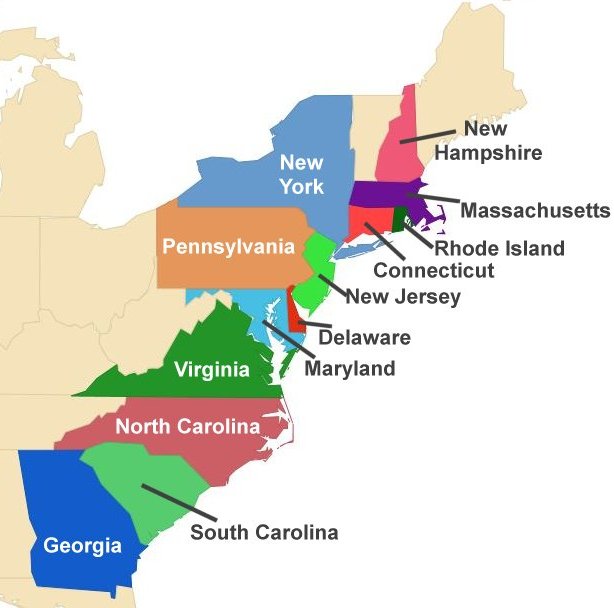
By the end of the 17th century Britain’s holdings in America comprise thirteen colonies, along the Atlantic coast.
Approximate Dates And Charters For The Thirteen Crown Colonies
| Date | Name | Founded by | Announced Purpose |
| 1607 | Virginia | The London Co | To find gold |
| 1620 | Plymouth (Mass) | Separatist Puritans | To separate from the Church of England |
| 1630 | Massachusetts Bay | Reform Puritans | To reform the Church of England |
| 1635 | Connecticut | Thomas Hooker | For Puritan gentlemen. |
| 1636 | Rhode Island | Roger Williams | For total religious freedom (and Baptists) |
| 1664 | New York | The Dutch | To secure and trade furs |
| 1664 | New Jersey | The Dutch | For farming |
| 1692 | New Hampshire | John Mason | For farming |
| 1632 | Maryland | Lord Baltimore | To secure religious freedom for Catholics |
| 1681 | Pennsylvania | William Penn | To secure religious freedom for Quakers |
| 1703 | Delaware | New Sweden Co | For farming |
| 1719 | Carolinas | Virginians | For farming and trade |
| 1732 | Georgia | James Oglethorpe | To provide relief for the English in poverty |
They are a diverse lot to say the least. All favor the English language and share some form of allegiance to the crown; but their make-up and missions often have little in common.
The three New England colonies (Massachusetts, Connecticut and Rhode Island) probably come closest to a shared purpose – that being a wish to practice the Puritan religion without interference from the Church of England hierarchy back home. The Puritans are committed to driving all residual traces of Catholicism out of their worship and living lives of “Christian charity” according to the principles of the French theologian, John Calvin (1509-64).
- Total depravity: All men are born as sinners.
- Unconditional election: God selects which will be saved and which damned.
- Limited atonement: Christ died only for those who are to be saved.
- Pre-destination: Man cannot affect his own salvation through deeds or prayer.
But even within this umbrella of Puritanism, there are fissures. Those clustered in Massachusetts Bay wish to stay within the Church of England, while reforming it as they see fit. The Puritan “pilgrims” of Plymouth, Massachusetts, opt for creating a separate church entirely. The Rhode Islanders, under the break-away Puritan preacher Roger Williams, are eager to explore other new religious approaches, notably the Baptist movement.
Two other colonies are also predicated on offering citizens the right to practice their own form of religion. In Maryland, Cecil Calvert, 2nd Baron Baltimore, establishes a haven for Roman Catholic settlers in the New World. In Pennsylvania, the English real estate magnate, William Penn, provides a home for Quakers.
Georgia is also focused on a higher calling, in this case secular in nature and aimed at providing a better life for settlers caught in the misery of poverty back home in England.
Time: 1534-1682
France Opens Canada And The Mississippi Valley
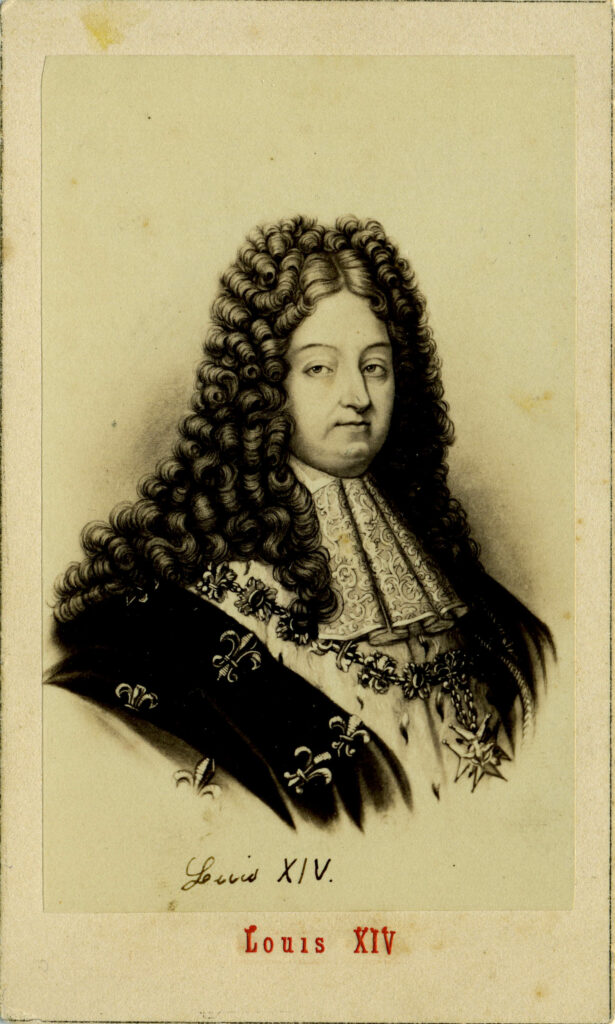 The Sun King, Louis VI of France (1638-1715)
The Sun King, Louis VI of France (1638-1715)France’s interest in America picks up during the 72-year reign (1643-1715) of Louis XIV, the Sun King, who is arguably the dominant force in Europe in his time.
In search of fur trading outposts, the French locate and explore the great waterways into and across America.
They arrive from the North in 1534, with Jacque Cartier’s 1000-mile voyage down the St. Lawrence seaway. In 1541 Cartier sets up the first European settlement in North America, 400 strong, at Cap Rouge (Quebec City). But a year later it is abandoned, owing to an unforgiving winter climate and conflicts with local tribes.
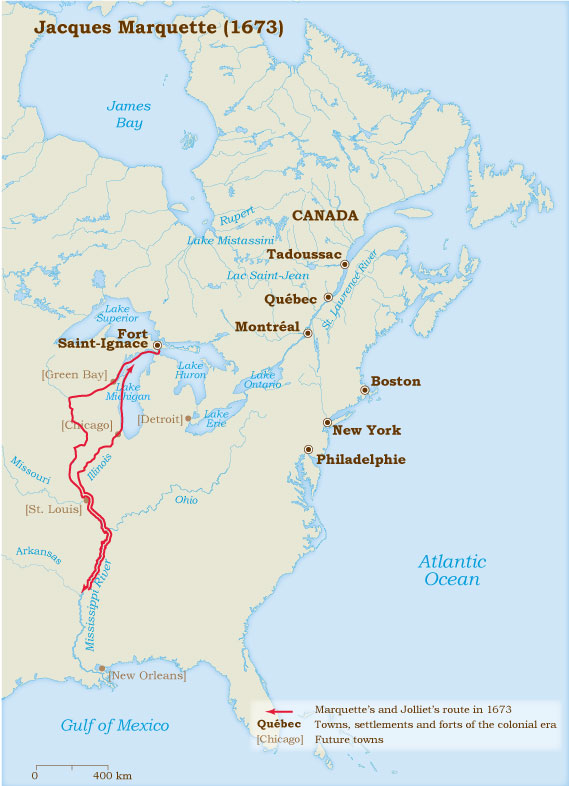
From there, the French drive west proceeds, across Canada and the Great Lakes to the mighty Mississippi, led by Jean Nicollet, Louis Joliet and Father Jacques Marquette.
| Years | Explorer | From | Land Covered |
| 1534-41 | Cartier, Jacques | France | 1000 miles up St Lawrence seaway |
| 1540-42 | Coronado, Francisco | Spain | Arizona, NM, Texas, Oklahoma, Kansas |
| 1577-80 | Drake, Sir Francis | England | 2nd after Magellan around the world, California |
| 1584-87 | Raleigh, Sir Walter | England | Roanoke colony (NC) in 1584-87, Florida |
| 1596-1602 | Vizcaino, Sebastian | Spain | Pacific coast, San Diego to Oregon |
| 1603-09 | Champlain, Samuel | France | Settles Quebec |
| 1606-14 | Smith, John | England | Jamestown in 1607, Richmond, Baltimore |
| 1609-11 | Hudson, Henry | England | New York (for Dutch East Indies Co.), Hudson R |
| 1618-42 | Nicollet, Jean | France | Canada, Great Lakes, Wisconsin, Illinois |
| 1626-38 | Minuit, Peter | Dutch | Bought Manhattan I in 1826 for the Dutch East Co |
| 1645-72 | Stuyvesant, Peter | Dutch | Governor of New Amsterdam (NYC), West Indies |
| 1673 | Joliet, Louis | Canada | Mississippi R (Green Bay to Arkansas) |
| 1673 | Marquette, Jacques | France | Mississippi R along with Joliet |
| 1679-82 | De La Salle, Robert | France | Great Lakes and length of Mississippi |
| 1774-1830 | DuSable, Jean | France | Chicago, Michigan, Missouri |
Along the way, French forts and outposts translate into many of the enduring cities of the Midwest.
| Year | Location |
| 1608 | Quebec City |
| 1642 | Montreal |
| 1669 | Ft. La Baye (Green Bay) |
| 1679 | Ft. Niagra |
| 1680 | Ft. Crevecoeur (Peoria,IL) |
| 1698 | Caho Kia (Cahokia, IL) |
| 1699 | Biloxi |
| 1701 | Ft. Ponchetrain (Detroit) |
| 1716 | Ft Rosalie (Natchez) |
| 1718 | La Nouvelle Orleans |
| 1720 | Baton Rouge |
| 1780’s | Chicago |
In honor of King Louis XIV, the New France territories along the Mississippi are christened “Louisiana.”